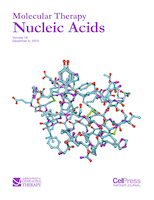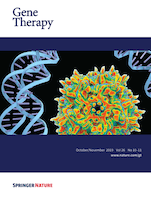
Molecular Therapy Nucleic Acids
Scope & Guideline
Exploring the frontiers of drug discovery with nucleic acids.
Introduction
Aims and Scopes
- Gene Editing Technologies:
This area encompasses advancements in CRISPR, TALENs, and other gene editing techniques aimed at correcting genetic disorders, improving genomic stability, and developing novel therapeutic strategies. - Nucleic Acid Delivery Systems:
Research in this scope focuses on the development of novel carriers and delivery mechanisms, such as lipid nanoparticles, exosomes, and viral vectors, to enhance the cellular uptake and efficacy of nucleic acid therapeutics. - RNA Therapeutics:
The journal emphasizes the therapeutic potentials of various RNA molecules, including mRNA, siRNA, and circular RNAs, exploring their roles in gene regulation, disease treatment, and potential applications in cancer and genetic disorders. - Mechanisms of Action and Safety:
Research that investigates the mechanisms through which nucleic acid therapies exert their effects and the safety profiles of these treatments, including off-target effects and immune responses. - Translational Research:
The journal also focuses on the translation of basic research findings into clinical applications, emphasizing studies that bridge laboratory discoveries with patient care.
Trending and Emerging
- Enhanced CRISPR-Cas9 Techniques:
Recent publications highlight advancements in CRISPR-Cas9 technology, including improved specificity and efficiency, as well as novel applications in gene therapy for complex diseases. - RNA Modifications and Their Therapeutic Implications:
There is an increasing focus on understanding how RNA modifications, such as m6A, influence the stability and function of therapeutic RNAs, opening new avenues for enhancing RNA-based therapies. - Circular RNAs as Therapeutics:
Research into the therapeutic potential of circular RNAs is gaining momentum, exploring their roles in disease mechanisms and their utility as novel therapeutic agents. - AI and Machine Learning in RNA Research:
The integration of artificial intelligence and machine learning techniques in the design and optimization of RNA therapeutics is emerging as a significant trend, showcasing the potential for computational approaches to enhance nucleic acid therapy development. - Exosome-Mediated Delivery Systems:
Publications are increasingly focusing on exosomes as natural carriers for delivering RNA therapeutics, capitalizing on their biocompatibility and ability to evade immune detection.
Declining or Waning
- Traditional Gene Therapy Approaches:
There is a noticeable decline in research focused on older gene therapy methods that do not utilize contemporary techniques such as CRISPR or innovative delivery systems. This shift reflects the field's movement towards more advanced technologies. - Basic Mechanistic Studies of RNA Interference:
Studies that focus solely on the fundamental aspects of RNA interference without translational applications are becoming less common, as the field increasingly prioritizes applied research with direct therapeutic implications. - In Vivo Models in Preclinical Studies:
Research utilizing traditional animal models for initial testing of nucleic acid therapies may be waning, as there is a growing trend towards more sophisticated models, such as organoids or humanized systems, that better mimic human pathophysiology.
Similar Journals

CURRENT GENE THERAPY
Advancing the Future of Genetic Medicine.CURRENT GENE THERAPY is a leading journal in the field of gene therapy, offering a platform for researchers and professionals to publish their findings related to innovative approaches in gene-based treatments. Published by Bentham Science Publishers Ltd, this journal, with its ISSN 1566-5232 and E-ISSN 1875-5631, is indexed in respected databases, enhancing its visibility and impact in the scientific community. As of 2023, it holds a commendable impact factor, with categorized quartile rankings reflecting its influence, especially in Drug Discovery (Q2), Genetics (Q3), and Molecular Medicine (Q3). Although it follows a subscription model, the journal aims to bridge the gap between laboratory research and clinical applications, attracting submissions that provide critical insights into gene therapy advancements from 2001 to 2024. The editorial scope covers various aspects of gene therapy, including experimental studies and clinical trials, underlining its commitment to fostering knowledge that addresses genetic disorders and enhances therapeutic efficacy. Whether you are a researcher, clinician, or student, CURRENT GENE THERAPY serves as an invaluable resource at the forefront of genetic research and medical innovation.

MOLECULAR BIOLOGY OF THE CELL
Elevating the Science of Cell BiologyMOLECULAR BIOLOGY OF THE CELL is a prestigious journal published by the American Society for Cell Biology, focusing on the latest advancements in cell biology and molecular biology. Established in 1990, this journal serves as a vital forum for disseminating innovative research, methodologies, and insights that drive the understanding of cellular processes and their implications in health and disease. With a noteworthy impact factor and recognition within the top quartiles for both Cell Biology and Molecular Biology, it ranks prominently among its peers, with Scopus rankings reflecting its significance in the scientific community. Although the journal does not follow an open access model, it provides essential access options for both institutional and personal subscriptions. Researchers, professionals, and students seeking to expand their knowledge and collaborate on groundbreaking findings will find MOLECULAR BIOLOGY OF THE CELL an invaluable resource in the field.

Frontiers in Molecular Biosciences
Fostering Collaboration in Cutting-Edge Molecular ResearchFrontiers in Molecular Biosciences is an esteemed open-access journal published by FRONTIERS MEDIA SA, based in Switzerland. Since its inception in 2014, the journal has made significant strides in the fields of biochemistry, genetics, and molecular biology, cementing its reputation with a solid position in the Q1 quartile for both Biochemistry and Genetics and Molecular Biology (miscellaneous) categories as of 2023. With a remarkable Scopus rank of #14/103 in the combined categories, it offers an essential platform for the dissemination of high-quality research that shapes the understanding of molecular processes and their implications in health and disease. The journal’s commitment to open access facilitates the broadest possible reach for groundbreaking discoveries, serving as a vital resource for researchers, professionals, and students alike. Located at AVENUE DU TRIBUNAL FEDERAL 34, LAUSANNE, this journal continues to foster innovative discussions and advancements in molecular biosciences, paving the way for new insights and collaborations in the scientific community.

INTERNATIONAL JOURNAL OF MOLECULAR MEDICINE
Unveiling the complexities of genetics and clinical applications.International Journal of Molecular Medicine is a prestigious publication dedicated to advancing the field of molecular medicine through innovative research and scholarly dialogue. Published by Spandidos Publications Ltd in Greece, this journal has successfully provided a platform for academics and professionals alike since its inception in 1998. With an impressive 2023 Q1 ranking in Medicine (Miscellaneous) and a Q2 ranking in Genetics, the journal maintains a vital role in disseminating high-quality research, underscored by its strong performance in the Scopus rankings, particularly in the realm of genetics where it ranks 28 out of 347. Researchers will benefit from its comprehensive scope, which encompasses a wide range of topics within molecular biology, genetics, and their clinical applications. Although the journal does not operate under an open access model, it remains influential, providing critical insights that contribute significantly to the understanding and development of molecular therapeutic strategies and innovations.

Molecular Diagnosis & Therapy
Exploring Pathways to Precision MedicineMolecular Diagnosis & Therapy, published by ADIS INT LTD, is a premier journal dedicated to the cutting-edge fields of genetics, molecular medicine, and pharmacology. With a strong emphasis on the translation of molecular insights into innovative therapeutic strategies, this journal serves as a vital resource for researchers, clinicians, and students aiming to stay at the forefront of medical and scientific advancements. The journal boasts an impressive standing in its categories, holding a Q1 ranking in Genetics, Medicine (miscellaneous), and Pharmacology, alongside a Q2 classification in Molecular Medicine for 2023, reflecting its influential contributions to the scientific community. Indexed in Scopus, it occupies distinct positions in its respective fields, ranked #77 in Genetics and Pharmacology, and #53 in Molecular Medicine, highlighting its robust impact factor and scholarly influence. Although it is not open access, the journal ensures widespread dissemination of valuable research, promoting enhanced understanding of molecular diagnostic techniques and therapeutic interventions. Since its inception in 2001, and continuing through to 2024, Molecular Diagnosis & Therapy remains an essential platform for disseminating vital research findings, fostering academic collaboration, and driving forward the dialogue in molecular diagnostics and treatment methodologies.

CELLULAR & MOLECULAR BIOLOGY LETTERS
Transforming Knowledge in Biochemistry and Cell BiologyCELLULAR & MOLECULAR BIOLOGY LETTERS, published by BMC, is a premier open-access journal dedicated to disseminating high-quality research in the fields of Biochemistry, Cell Biology, and Molecular Biology. Established in 1996, the journal has emerged as a leader in its domain, boasting an impressive Q1 ranking across three critical categories as of 2023, reflecting its significant impact within the scientific community. With an ISSN of 1425-8153 and an E-ISSN of 1689-1392, it offers accessible research findings to a global audience, having been open access since 2013. Situated in the United Kingdom, at CAMPUS, 4 CRINAN ST, LONDON N1 9XW, the journal continues to serve as a vital resource for researchers, professionals, and students, contributing to advancements in the understanding of cellular and molecular processes. By providing a platform for original research, reviews, and short communications, CELLULAR & MOLECULAR BIOLOGY LETTERS plays a crucial role in fostering dialogue and collaboration within the scientific community.

GENE THERAPY
Pioneering Innovations in Genetic HealingGENE THERAPY, published by SpringerNature, is a prestigious academic journal at the forefront of research in the fields of genetics, molecular biology, and molecular medicine. Since its inception in 1994, this journal has evolved into a vital resource for scholars, practitioners, and students, providing cutting-edge insights into gene therapy techniques and innovations. With an impressive impact factor reflecting its significant influence— ranking in the Q1 quartile across multiple categories in 2023—GENE THERAPY offers rigorous peer-reviewed articles that address both basic and applied aspects of gene therapy. The journal is recognized for its role in promoting advancements in therapeutic strategies, thus enhancing understanding of genetic disorders and treatment efficacy. Researchers will find this journal invaluable for publishing their findings, staying updated on the latest breakthroughs, and fostering interdisciplinary collaborations. Engage with the latest in gene therapy by accessing this influential platform, and contribute to a field that holds the potential to transform healthcare outcomes worldwide.

JOURNAL OF OCULAR PHARMACOLOGY AND THERAPEUTICS
Advancing ocular health through innovative research.JOURNAL OF OCULAR PHARMACOLOGY AND THERAPEUTICS, published by Mary Ann Liebert, Inc, stands at the forefront of research in the realms of ophthalmology and pharmacology. Established in 1985 and converging until 2024, this esteemed journal is dedicated to advancing the understanding of ocular pharmacology, drug therapies, and therapeutic approaches in the treatment of eye diseases. With an impressive impact factor and categorized in the Q2 quartile for both Ophthalmology and Medical Pharmacology, it showcases pivotal research in the field, reflecting its rank of #31 among 137 in Ophthalmology and #109 among 272 in Medical Pharmacology per Scopus metrics. Although it follows a subscription-based model, the journal provides critical insights and empirical studies that foster innovation and collaboration for researchers, professionals, and students alike in the pursuit of improving ocular health.

CANCER GENE THERAPY
Unleashing the Power of Molecular Medicine in OncologyCancer Gene Therapy, published by SpringerNature, stands at the forefront of research in the fields of cancer research, molecular biology, and molecular medicine. With a robust impact factor reflecting its significant influence—ranking in the Q2 category for cancer research and Q1 for both molecular biology and molecular medicine—it serves as an essential resource for scholars and practitioners alike. Since its inception in 1994, the journal has dedicated itself to advancing the understanding and therapeutic application of genetic innovations in oncology. Notably, it holds distinguished Scopus ranks, placing it among the top tier journals in its categories, underscoring its importance to the scientific community. While open access options are not available, the compelling research published here offers invaluable insights into the latest advancements and strategies in cancer therapy. Engaging with *Cancer Gene Therapy* not only keeps professionals informed but also inspires future innovations in the quest for effective cancer treatments.

Non-coding RNA Research
Pioneering Research at the Intersection of Genetics and MedicineNon-coding RNA Research, published by KEAI PUBLISHING LTD, is a leading open-access journal dedicated to advancing the field of non-coding RNA, a critical component in the landscape of molecular biology and genetics. Established in 2016, this journal aims to provide a platform for the dissemination of high-quality research focusing on the roles, mechanisms, and therapeutic potentials of non-coding RNAs in various biological processes and diseases. With impressive Scopus rankings placing it in the top quartile for both Biochemistry and Medical Biochemistry, as well as notable standings in Genetics and Molecular Biology, Non-coding RNA Research continues to attract contributions from globally recognized experts. The journal's commitment to open access ensures broad visibility and engagement with cutting-edge discoveries, thereby fostering an inclusive scientific dialogue that enhances understanding and innovation in this rapidly evolving field. For researchers and scholars, the opportunity to publish in a Q1 ranked journal not only validates their work but also enhances its impact, making Non-coding RNA Research an indispensable resource for anyone interested in the intricate workings of non-coding RNA.